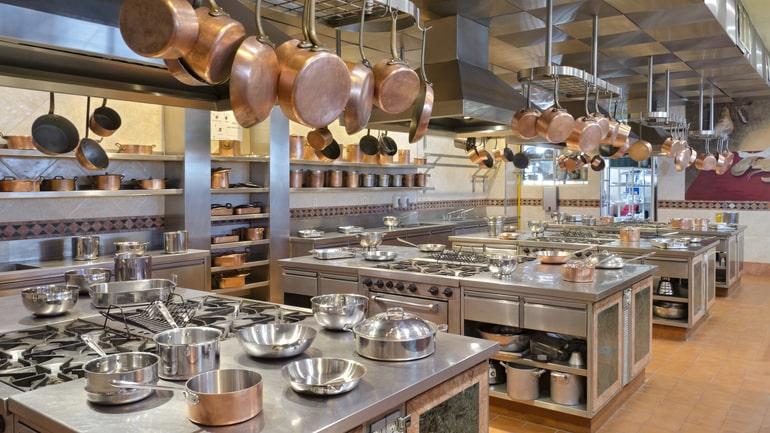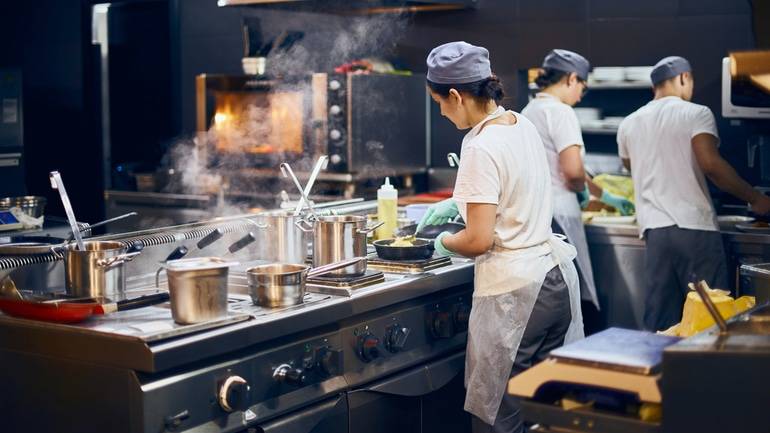The pandemic shook up the restaurant industry in unprecedented ways, forcing restaurants around the world to either shut down temporarily, or adapt to a takeout and delivery model exclusively.
Because of the need to find new and creative ways to drive revenue, the future of restaurants may lie in a trend that started several years ago – ghost kitchens and ghost restaurants.
Yet even after the pandemic-induced takeout and delivery boom has subsided, ghost kitchens certainly remain a popular option. For instance, B’Spoke Kitchen + Market in Barrie, Ontario, Canada, operates a virtual food hall that has only continued to grow, even after it reopened its indoor dining space.
Ghost kitchens don’t look like a typical restaurant – these particular haunts have no tables, chairs, host stands, bars, or patio. They do, however, still abide by health standards, employ a slew of cooks, and operate through a fleet of delivery couriers.
With customers now accustomed to having a plethora of options available for takeout and delivery on-demand, the idea of ghost restaurants and ghost kitchens may end up sticking around for good.
In this guide we’ll go over:
- What is a ghost kitchen versus a ghost restaurant
- The benefits and challenges of both set ups
- The overall impact of ghost kitchens and ghost restaurants on the industry

What Is a Ghost Kitchen?
Ghost kitchens – also commonly known as cloud kitchens or dark kitchens – are professional food preparation and cooking facilities, set up specifically for delivery-only meals. These kitchen operations are generally shared commissary kitchen spaces located outside the walls of a typical brick-and-mortar restaurant. And while they contain everything a typical restaurant kitchen would, they don’t have a dining area for walk-in customers. Generally, restaurants that use a ghost kitchen still have a physical location somewhere else for dine-in service or takeout, but the ghost kitchen is used to produce delivery meals.
In contrast, a ghost restaurant is a restaurant that only offers delivery from its brick and mortar location. Customers can order meals over the phone, online, or through third-party apps, but there is no option to enjoy a dine-in meal from a ghost restaurant brand.
Put simply, the main difference between a ghost restaurant and a ghost kitchen is that a ghost kitchen may not be a restaurant brand in itself and may contain the kitchen space and facilities for more than one restaurant brand.
4 Benefits of Ghost Kitchens
1) Less Space Needed
Many restaurants will use commercial kitchens that have no seating area to facilitate their delivery-only business. Space in the kitchen is maximized so that there’s more room for food prep and food output – this also enables the possibility of multiple menus to share the same commercial space.
For restaurants that do significantly more off-premise business than on-premise business, they may opt to temporarily close their location and expand their operation into delivery only through a ghost kitchen.
2) Capitalize on Increased Demand
As on-demand delivery flourished even before the pandemic hit, customers have come to expect that food delivery be effortless, available at all hours, and at their fingertips. The online ordering business overall was worth $5 billion for the first two quarters of 2018 alone, and some experts predict that the food delivery market could be valued at $365 billion by 2030.
Ghost kitchens allow restaurants to expand their online ordering business by increasing their exposure on third-party apps. For instance, a Mexican restaurant may use a ghost kitchen to launch a separate Tex-Mex brand, giving the restaurant a way to reach even more customers without opening a whole new location. In the wake of the pandemic, this helps restaurants better adapt to the increasing demand for delivery.
3) Additional Parking
Most restaurants have their customer-facing storefronts on busy streets, where parking can be an issue for couriers – especially in major urban centers. As a result, couriers are often faced with the tricky task of securing a spot close to the venue that won’t result in a ticket, but also won’t have them walking 10 blocks just to pick up an order.
In contrast, a ghost kitchen can operate with less space and doesn’t need to be in a high-foot-traffic, popular location. This means that parking is less likely to be an issue for delivery couriers in these quieter areas. These lots are also typically optimized for flow, making it easy for drivers to arrive, wait for their order, and drive off to their delivery location with ease.

4) Less Food Waste
Pre-pandemic, it’s estimated the U.S. restaurant industry was generating between 22 and 33 billion pounds of food waste each year. Not only is that a hit to a restaurant’s bottom line, but it’s environmentally unsound.
Ghost kitchens have the unique opportunity to minimize food waste and pare down inventory costs to be more economical. For example, restaurateurs that operate multiple brands can have all their restaurants in the same ghost kitchen, which allows them to strategically craft menus to share and reuse ingredients. Moreover, staff can be trained to prepare dishes according to dining style, but the nuts and bolts of the dishes remain the same across brands.
3 Challenges of Ghost Kitchens
1) Delivery Errors
Ghost kitchens aren’t exempt from the typical complications that come from offering delivery. From cold food due to poor takeout food packaging, to order errors and long wait times. Like all delivery operations, these are challenges felt by all delivery-reliant restaurants, but may be amplified when delivery is the primary or only revenue source.
2) Food Standards and Consistency
Lending truth to the phrase that there can really be “too many cooks in the kitchen,” multiple cooks, dealing with multiple brands and orders can create inconsistency, even in spite of ingredient standardization. Unless your back of house is divided in the kitchen between different menus, your cooks need to be trained at making many more dishes – and their accompanying modifications – than a single restaurant and kitchen.
This could result in a lack of consistency, or at the very least make it difficult to maintain specific brand and food standards. And a lack of consistency can compromise your ability to secure repeat business.
3) Less Ideal for Start-Up Restaurants
Ghost kitchens are more useful to restaurants looking to expand their delivery operation and reach more customers at a lower cost. For new restaurants that don’t have a foothold in the business or an existing audience to sell to, this could be a challenge.
A ghost kitchen’s appeal is the high volume, so knowing that it’s all about scaling an existing operation, the model may not make sense for a new restaurant.
What Is a Ghost Restaurant?
A ghost restaurant is just one restaurant brand, with its own brick and mortar location – not rented through a third-party kitchen – and currently only offering delivery.
Also known as the digital restaurant, virtual restaurant, or delivery-only restaurant, this concept is the natural offspring of over-saturated delivery app marketplaces.
At first, ghost restaurants emerged out of sheer competition and the challenge to meet delivery needs and the demands of a brick and mortar dinner service. Now, they offer restaurants a way to expand operations and add new revenue streams.

4 Benefits of Ghost Restaurants
1) Cost Savings
Ghost restaurants, by nature, operate in a smaller physical space and don’t require as many people to staff them. No front-of-house staff means lower operating costs, and a smaller space means lower rent costs.
These major cost savings give ghost restaurants some financial flexibility to operate and adapt to changing circumstances, such as shrinking dine-in revenue.
2) Location Options
The cost of rent in most city centers will likely continue to rise and the commercial real estate landscape will look very different once the pandemic is under control. Currently, it’s estimated that at least one in four restaurants will never open again, and because many office-based businesses moved to work-from-home models permanently, suggesting that we may see a shift in what makes a good location for a restaurant.
For ghost restaurants, there is more ownership over where you set up and operate your shop, and the opportunity to explore new neighborhoods with lower commercial rents
3) More Agile Concepts
Because ghost restaurant menus exist solely online, changing, shifting, and adapting to food trends is much more seamless. There’s no redesign or re-print of menus needed – restaurants can simply adjust what’s available online to reflect their new offerings.
Since the move to takeout and delivery has already forced many restaurants to adjust their menus to be as efficient as possible, this also means that food trends – like Hawaiian poké bowls, sushi burritos, or pandemic comfort food – are easy to introduce or remove when consumer preferences change.

4) Less Risk
Before the pandemic ever hit, the restaurant industry was already plagued with glass-half-empty stats. It’s reported that 60% of restaurants close or change ownership in the first year of business – 80% within the first five. For physical restaurant locations with hundreds of thousands of dollars on the line, opening a restaurant is a risky endeavor by nature.
Ghost restaurants, on the other hand, come with a much lower risk because of the reduced opening costs. Florida restaurant chain Kona Poké was planning to open up to seven corporate locations before the pandemic hit and has since pivoted to opening 20 ghost kitchen locations instead.
Because opening up a ghost restaurant is only a fraction of the cost of a typical restaurant, the cost of failure is lower too, meaning if the concept fails, the investment lost isn’t as high.
3 Challenges of Ghost Restaurants
1) Marketing and Customer Acquisition
For ghost restaurants, ironically, the biggest challenge is being visible. Without a physical storefront, all of their marketing must be done online. And it’s a crowded market, especially on third-party delivery apps where every restaurant is vying for a customer’s attention.
As a result, ghost restaurants need a very different kind of marketing plan in order to drive new business. And in some cases, they may be limited to the expensive marketing solutions available from third-party apps.
2) Maintaining Current Customers
Reputation management can also be a challenge because a ghost restaurant’s reputation is largely limited to the memory of its convenience and food quality. If a problem occurs with a guest’s meal, a restaurant owner may not discover the issue until a negative review pops up online after the fact. This means if something is wrong with an order, there’s little that ghost restaurants can do to redeem the customer experience at the time.
This is a far cry from the typical dine-in experience, where a restaurant has the chance to make a lasting impression on guests with exceptional service and ambiance. If there’s a problem, the owner can simply send over a manager to chat with a guest one-on-one.
And because the experience is far less hands on, it can be particularly challenging for fine dining restaurants that charge a premium for exceptional service, like sending over a sommelier to pick out just the right wine to go with your meal. For ghost restaurants, that special experience is entirely confined to a takeout box.
3) Lost Revenue Opportunities
It’s no secret that restaurants make a large portion of their sales from marked up alcohol. But in most places, ghost restaurants don’t have this option. Even though many places in North America have revised their liquor laws for delivery and takeout, ghost restaurants have to find other ways to make up for the loss of revenue because, even if they can offer alcohol to go, it may not be as frequent with takeout as it is with dine-in.
The Future of Restaurants
It may still be too early to tell how the pandemic will impact the restaurant industry and consumer behavior long-term. A recent survey showed that only 51% of people plan to dine out as often as they did pre-pandemic.
That said, disruption often fuels innovation. Ghost kitchens have given restaurants an avenue to test out new concepts, experiment with different business models, and adapt to a new future that’s less reliant on the dine-in experience.
Free job application template for restaurants
Sign up for our free weekly TouchBistro Newsletter







